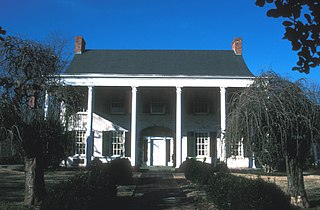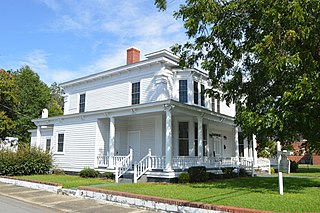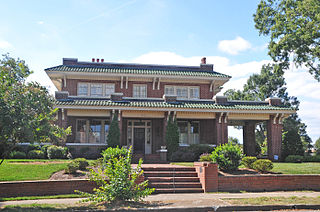The Blackstone Boulevard Realty Plat Historic District is a historic district roughly bounded by Blackstone Blvd., Rochambeau Ave., Holly St. and Elmgrove Ave. in Providence, Rhode Island.

Cannondale Historic District is a historic district in the Cannondale section in the north-central area of the town of Wilton, Connecticut. The district includes 58 contributing buildings, one other contributing structure, one contributing site, and 3 contributing objects, over a 202 acres (82 ha). About half of the buildings are along Danbury Road and most of the rest are close to the Cannondale train station .The district is significant because it embodies the distinctive architectural and cultural-landscape characteristics of a small commercial center as well as an agricultural community from the early national period through the early 20th century....The historic uses of the properties in the district include virtually the full array of human activity in this region—farming, residential, religious, educational, community groups, small-scale manufacturing, transportation, and even government. The close physical relationship among all these uses, as well as the informal character of the commercial enterprises before the rise of more aggressive techniques to attract consumers, capture some of the texture of life as lived by prior generations. The district is also significant for its collection of architecture and for its historic significance.

Claremont High School Historic District is a national historic district located at Hickory, Catawba County, North Carolina. The district encompasses 172 contributing buildings and 3 contributing structures in a predominantly residential section of Hickory. Most of the dwellings date from the late 19th through mid-20th century and include notable examples of Queen Anne, Colonial Revival, Tudor Revival, and Bungalow / American Craftsman style architecture. The Claremont High School was completed in 1925, and is a three-story, "H"-shaped, Neoclassical style school. The school was rehabilitated in 1986 as an arts and science center. Other notable buildings include Maple Grove, Shuler-Harper House (1887), Harvey E. McComb House (1889), (former) Corinth Reformed Church Parsonage (1895), Shuford L. Whitener House, Judge W. B. Councill House (1902), George W. Hall House, Carolina Park, Josephine Lyerly House, John L. Riddle House (1918), Marshall R. Wagner House (1938), David M. McComb Jr. House (1939), Arthur H. Burgess House (1940), and R. L. Noblin House (1950).
Rose Hill is a historic tobacco plantation house and national historic district located near Grassy Creek, Granville County, North Carolina. The house was built about 1834, and is a two-story, three bay by two bay, Greek Revival style red brick dwelling. It has a low hipped roof and a Colonial Revival style front porch added in the late-19th or early-20th century. Also on the property are the contributing garage, two frame corn cribs, four log tobacco barns, a log striphouse, a frame packhouse, and a tenant house.

Dr. C. S. Grayson House is a historic home located at High Point, Guilford County, North Carolina. It was designed by architect Harry Barton and built between 1923 and 1925. It is a 2+1⁄2-story, three-bay, gray granite dwelling in an eclectic Colonial Revival style with American Craftsman influence. It has a slightly flared hipped roof, porte cochere, and one-story full-facade front porch. Also on the property is a contributing garage.

Tillery-Fries House, also known as Conoconnara Hall, The Mansion, and Oak Grove, is a historic plantation complex located near Tillery, Halifax County, North Carolina. The Federal-style main house was built about 1800, and enlarged and remodeled about 1891 in the Colonial Revival style. It is a large, two-story with attic gable-roofed, frame dwelling with a two-story wing. It features full-facade one-story porches at the front and rear of the house supported by full Tuscan order columns. Also on the property are the contributing smokehouse, dairy, storage shed, overseer's house, and manager's cottage.

Charlton Leland, also known as the Dr. E.B Goelet House and Saluda Inn, is a historic home located at Saluda, Polk County, North Carolina. It was built about 1896, as a 2+1⁄2-story, Queen Anne style frame dwelling with a wraparound porch. It was enlarged and remodeled in the Colonial Revival style when converted to an inn in 1914. It rests on an ashlar-face stone foundation and is capped by a gable-on-hip roof with a prominent front gable. The building houses a retreat house known as the Saluda Inn.

Ryder Hall, also known as the Mountain Manor Hotel and Cloud Hotel, is a historic hotel located at Saluda, Polk County, North Carolina. It was built in 1909, as a girls' dormitory for the Saluda Seminary that operated until 1922. It is a 2+1⁄2-story, "H"-plan, Colonial Revival style frame building sheathed in weatherboard. It has a gambrel roof with shed-roof dormers and features full-width one-story shed roof porches on the front and rear elevations. It housed a public school until 1927, then was converted to a hotel. It was converted to a single-family dwelling after 1992.

Penn House is a historic home located at Reidsville, Rockingham County, North Carolina. The main house was built in 1932, and is a 2+1⁄2-story, Colonial Revival style blond brick dwelling. The house consists of the main block; a one-story, L-shaped wing; a one-story servants' quarters; and a one-story kitchen wing behind the main block. The front facade features a full-facade, full-height portico with six Corinthian order columns. It replaced a Prairie School inspired dwelling erected on the site about 1910. Also on the property are the contributing two-story garage and servants' apartment ; smokehouse ; slate-roofed gazebo; pump house (1922-1929); and two greenhouses.
The Griffith–Sowers House is a United States historic home located near Salisbury, Rowan County, North Carolina. It was built between 1930 and 1932 and is a large two-story, Colonial Revival style frame country house. It features a five-bay wide center block that is covered by a side-gable slate roof and linked by shallow one-bay wide hyphens to flanking, recessed, and perpendicular gable-front two-story wings. Other features include the poultry house, barn, small storage building, and landscaped grounds.

James Dexter Ledbetter House is a historic home located near Forest City, Rutherford County, North Carolina. It built in 1914, and is a 2+1⁄2-story, three-bay, double pile frame dwelling with Classical Revival and Colonial Revival style design elements. It sits on a low brick foundation and has a hipped roof. The front facade features a two-story engaged portico supported by Tuscan order columns, with a one-story wraparound section also supported by Tuscan columns.

Henrietta-Caroleen High School, also known as Tri-High, Tri-Community Elementary, and Chase Middle School, is a historic high school building located near Mooresboro, Rutherford County, North Carolina. It was designed by architect Leslie Boney (1880-1964) and built in 1925. It is a two-story on basement, "T"-plan, Classical Revival style red brick building. The front facade features a monumental, two-story, portico with a denticulated pediment supported by fluted Corinthian order columns. A brick gymnasium addition was built in 1935 and a hip-roofed, concrete block, addition to it was added in 1952. Also on the property are the contributing cafeteria building, and a World War II Commemorative Marker. The building houses Thomas Jefferson Classical Academy, a public charter school.
Delta Farm, also known as the J.W. Scott Robinson Farm, is a historic home and farm located near Ivanhoe, Sampson County, North Carolina. The house was built in 1910, and is a two-story, five bay by four bay, double pile, Colonial Revival style frame dwelling. It has a hipped roof with front gable, brick pier foundation, and a front wrap-around porch. The interior features excellent woodwork. Also on the property are the contributing gas house, two-room servants-ironing house, two smokehouses, a storage house, root cellar, the remnants of the washhouse, and a former brick flower pit.

Patrick-Carr-Herring House, also known as the Second Sampson County Courthouse, is a historic home located at Clinton, Sampson County, North Carolina. It was built about 1904–1905, and is a two-story, three-bay, double pile, Classical Revival / Greek Revival style frame dwelling with a low-pitched hip roof. It was originally built as a 1+1⁄2-story structure on tall brick piers in 1818, and enlarged to a full two stories in the Greek Revival style on a full one-story brick basement in the 1840s. It was moved to its present site, and remodeled, in 1904–1905, when the current Sampson County Courthouse was constructed. The front features a single-story wraparound porch with Tuscan order columns and bracketing. Also on the property is a contributing smokehouse.
William E. Faison House is a historic home located near Giddensville in Sampson County, North Carolina. It was built about 1870, and is a two-story, double-pile, frame dwelling, with Greek Revival and Italianate style design elements. It has a hipped roof; one-story, gable roofed rear ell; and features a one-story front porch. Also on the property is the contributing family cemetery.

Thomas Marcellus Denning House, also known as the Randall House, is a historic home located at Albemarle, Stanly County, North Carolina. It was designed by architect Louis H. Asbury and built in 1924–1925. It is a two-story, double pile, Spanish Colonial Revival style brick dwelling. It features bracketed, tiled pent cornices; full-façade porch with a parapet roof; and a side/sun porch with a porte cochere. Also on the property is a contributing brick garage.
Leak-Chaffin-Browder House is historic home located near Germanton, Stokes County, North Carolina. It was built between about 1853 and 1860, and is a large two-story, Greek Revival style brick dwelling. It has a Colonial Revival style front porch that dates from the early 20th century. Also on the property are the contributing kitchen-slave/servants' house, granary / tobacco pack house, wood shed, privy, shed, barn, and combination corn crib, equipment shed, and meat house.
Machpelah, also known as Macpelah, McPelah, and the Robert B. Taylor Farm, is a historic home and farm located near Townsville, Vance County, North Carolina. The Edward O. Taylor House was built about 1880, and is a two-story, "T"-shaped, vernacular frame dwelling with Greek Revival, Queen Anne, and Colonial Revival details. Also on the property are the contributing single-story, timber-frame Greek Revival plantation office building ; oil house ; well ; salting house and dovecote; privy ; henhouse ; flower pit ; 1 1/2-story modest Colonial Revival style guesthouse (1954); five tenant houses ; feed house ; two stables ; corn crib ; two cemeteries; and the farm landscape.
Dr. Nathan M. Blalock House is a historic home located near Raleigh, Wake County, North Carolina. It was built about 1910, and is a two-story, double-pile, Classical Revival-style frame dwelling with a hipped roof. The front facade features a full height, projecting pedimented portico supported by two pairs of fluted wood Ionic order columns and one-story wraparound porch. Also on the property are the contributing well house and wall.
The David M. Buck House is a historic house located near Bald Mountain, Yancey County, North Carolina.















